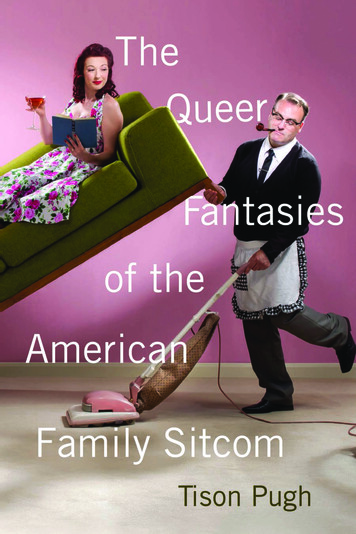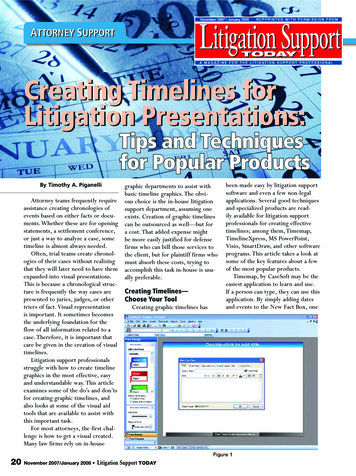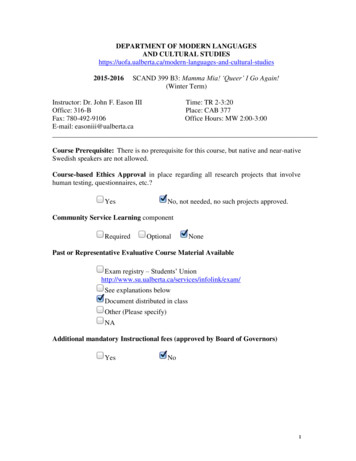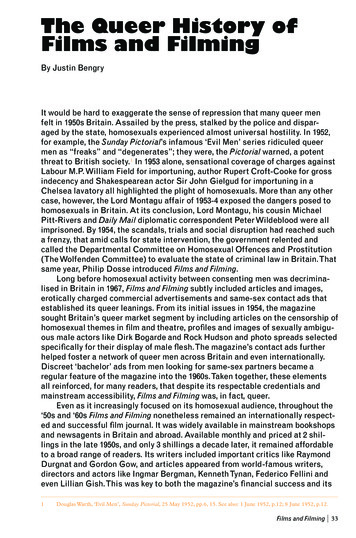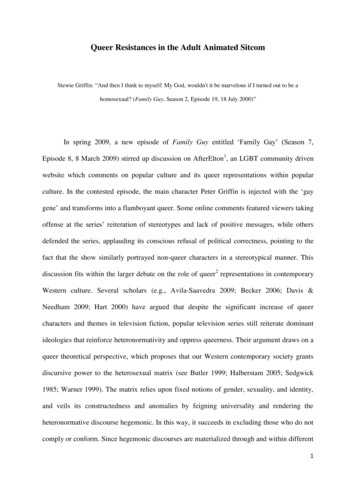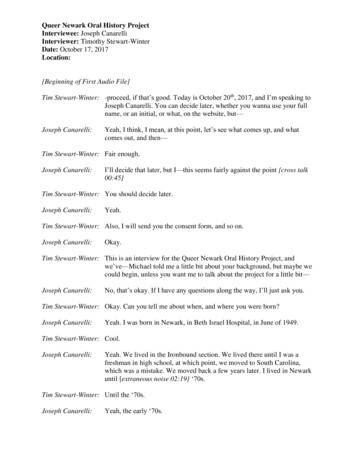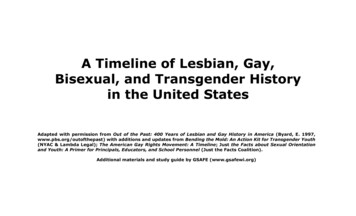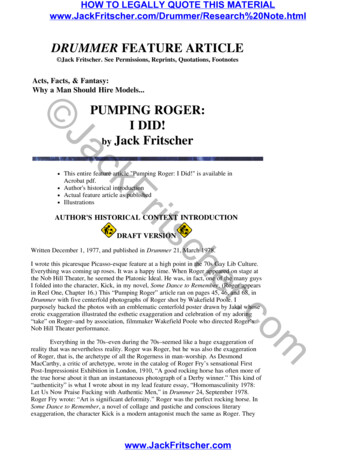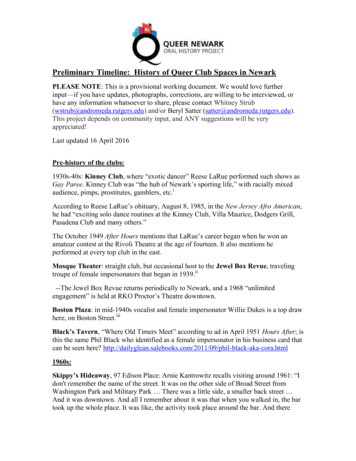
Transcription
Preliminary Timeline: History of Queer Club Spaces in NewarkPLEASE NOTE: This is a provisional working document. We would love furtherinput—if you have updates, photographs, corrections, are willing to be interviewed, orhave any information whatsoever to share, please contact Whitney Strub(wstrub@andromeda.rutgers.edu) and/or Beryl Satter (satter@andromeda.rutgers.edu).This project depends on community input, and ANY suggestions will be veryappreciated!Last updated 16 April 2016Pre-history of the clubs:1930s-40s: Kinney Club, where “exotic dancer” Reese LaRue performed such shows asGay Paree. Kinney Club was “the hub of Newark’s sporting life,” with racially mixedaudience, pimps, prostitutes, gamblers, etc.iAccording to Reese LaRue’s obituary, August 8, 1985, in the New Jersey Afro American,he had “exciting solo dance routines at the Kinney Club, Villa Maurice, Dodgers Grill,Pasadena Club and many others.”The October 1949 After Hours mentions that LaRue’s career began when he won anamateur contest at the Rivoli Theatre at the age of fourteen. It also mentions heperformed at every top club in the east.Mosque Theater: straight club, but occasional host to the Jewel Box Revue, travelingtroupe of female impersonators that began in 1939.ii--The Jewel Box Revue returns periodically to Newark, and a 1968 “unlimitedengagement” is held at RKO Proctor’s Theatre downtown.Boston Plaza: in mid-1940s vocalist and female impersonator Willie Dukes is a top drawhere, on Boston Street.iiiBlack’s Tavern, “Where Old Timers Meet” according to ad in April 1951 Hours After; isthis the same Phil Black who identified as a female impersonator in his business card thatcan be seen here? -aka-cora.html1960s:Skippy’s Hideaway, 97 Edison Place: Arnie Kantrowitz recalls visiting around 1961: “Idon't remember the name of the street. It was on the other side of Broad Street fromWashington Park and Military Park There was a little side, a smaller back street And it was downtown. And all I remember about it was that when you walked in, the bartook up the whole place. It was like, the activity took place around the bar. And there
wasn’t much activity that I was seeing, it was mostly people sitting there having a drink.It was pretty quiet. Newark not being a noted gay center. There was plenty of activitygoing on in Newark, but you know people were just hiding out even from each other.”iv--appears to have changed name to Gemini Lounge, as listed in 1968 Damron Guide;disappears from 1971 guide.Four Leaf Deli and Bar: writes Archbishop Carl Bean, Prelate-Unity Fellowship ChurchMovement and singer of the 1977 disco hit “I Was Born This Way”: “My history inNewark as an Alex Bradford Singer and openly gay man is: Alex hung out inneighborhood bars and therefore so did we. There was a very comfortable mixing of gayand straight Jersey folk. The Four Leaf Deli and Bar, a small bar just off the 100 block ofSouth 8th St., also on Central Ave. Off 8th!!!!! Often the Key Club to hear Jazz, JimmyScott, Sarah Vaughan etc. As I remember there was a few rather small Black Gay Barspre-disco but I don't recall their names.”Jackson’s Lounge on Howard Street: “may be the largest gathering place for lesbiansand homosexuals in any city of Newark’s size Every time its doors opened, music andlaughter spilled out,” writes journalist Ron Porambo in 1971, who goes on, inhomophobic language: “A bulldagger and a fag began yelling at one another in front ofthe bar. They began fighting faggot-style, running up and down the sidewalk and aroundthe parked cars while the crowd of lesbians and homosexuals in blond wigs shoutedencouragement to the fighters”vThis was perhaps the inspiration for Newark novelist Nathan Heard’s “M&M Bar” inthinly-fictionalized Third Ward novel Howard Street (1968), with descriptions ofdangerous “stud-broads” and “fags.” Deeply problematic, Heard is nonetheless vivid indepiction of the tangible qualities of the bar, which he wrote as loud, smelly, and overlit,but also a place of sanctuary for such groups as “five male couples queens with their‘husbands.’”viWaldorf Cafeteria: downtown hub for white gays in early 60s, seen in Dan Russo’smemoir Downtown, which sees Newark as a “thriving, cosmopolitan city,” with constantpolice harassment--“a band of SS officers.” Russo describes “Miss Coppertone, the olderserver at the Waldorf,” who “always dyed his hair red and spoke with a lisp.”viiSymphony Hall: not a club, but site of Disc-o-Teen dance-party TV show on Channel47. According to regular dancer Peter Savastano, “while not explicitly queer, it wasimplicitly so,” and “out of that show came a few famous queer club dance DJs, probablythe most famous of them being Richard Kaczor who was also a regular dancer on theshow.”Promenade Bar, 237 Park Ave.: listed in 1965 Damron Guide, otherwise very little yetknown.Murphy’s Tavern at 135 Mulberry Street joined with bars in New Brunswick andAtlantic City to challenge antigay discriminatory policy toward bars. Changes address to59 Edison Place between 1968 and 1970 Damron guides.2
--1967: New Jersey State Supreme Court delivered a sweeping victory for the gay bars,unanimously ruling that “well-behaved homosexuals cannot be forbidden to patronizetaverns.”viii--“only gay bar in Newark,” says John Francis Hunter in 1972ixClub 18: correspondent Sue reports by email, “My grandparents owned it in late 60's andearly 70's. I'd have to do some searching to get exact dates. It was one of the first gaytaverns.It was on the corner of 18th Ave and 12th Street. They had been robbed multiple timesand one year their dog Murphy was killed during the robbery. He was the guard dogthere.I grew up a few years sitting at the bar, drinking Shirley Temples and eating pork rinds.My grandma would tell me not to bother the men playing pool. I found out after herpassing the true history. I have very fond memories there as a little girl.It was a brick building with the enter emcee on the corner.If they renamed streets since then - it resembles the George and I Tavern on Ferry now!!”Peter Savastano also reports a moving drag ball that took place across downtownNewark in the late 1960s; more sources on this would be very useful.1970s:Al Murphy is a crucial figure. See Gary Jardim, Blue: Life, Art and Style in Newark,149-152, for his biography.Murphy was obsessed with Emily Miles, “the grand dame of black style in Newark,” “adark and beautiful model from old Newark” known for her fashion shows, featuring the“Jewel Box Revue, a Las Vegas stage-show like collection of dancers, comedians, andflamboyant female impersonators” (thus bringing things full circle in some sense; seeabove, Mosque Theatre).xAl Murphy gives fashion shows around Newark, including an annual Mother’s Day showthat “were a perennial favorite among women in Newark.” These shows were highlyextravagant, “a kind of grand theater.” Murphy brings in “chic high fashion models”including “Beverly Johnson, the first black woman to grace the cover of Vogue”; also“top New York models” like “Iman and Pat Cleveland.” These were combined with“funky choreographed dance-theater pieces choreographed by Darryl (Rochester), whowas an Alvin Ailey dancer.” “It was art.”xiDarryl Rochester graduates Weequahic High in 1971; sees Al Murphy as an “inspiringexample of how to be gay and free.” Al shows Darryl around the gay clubs in NYC.They hang out at “pre-disco lofts such as David Mancuso’s the Loft, Reade Street, andRichard Long’s loft .xii3
Rochester and Murphy are friends with Larry Patterson/ Paterson. Patterson was loverswith model Marvin Davis, and lived at 19 Lyons Ave in Newark, an area in Weequanicknown as “homo heights.” Patterson hosts a party scene there in early 1970s – around1972. Marvin has the grass, Larry does the music. Marvin was “Dionne’s cousin”(Dionne Warwick, I assume).xiiiAl Murphy also has elaborate house parties, held at his mother’s house on BayviewAvenue. Installs mirrored balls, very elaborate decoration. All predating Le Joc.xivClub North Baths, 49 Broadway: “daily 24 hrs. free buffet Fri. 8-10 P.M., steam &sauna, two dorms”xv First appears in 1970 Damron Guide, regularly advertised in eroticmen’s magazine Stallion in late 1970s, part of national Club Baths chain.The Other World, 390 N. 5th Street, Newark: ad in Hold Hands (Gay Activist Allianceof New Jersey newsletter), March 1975, claims “gayest gay bar” in NJ; two floors of“live disco music by Ronnie”; light show; waterbed. Ad lists “Michael and Jerry {Dee}”as presenters, also names Sammy, Mac, and Ray MaronexviLe Joc (or Le Jock), 36 Halsey Street, Newark.Established in June of 1974, closes sometime in 1976.xvii-Created by Albert Murphy, a regular at “The Loft” in NY, who hangs out withDavid Mancuso (creator of Loft, Paradise Garage, hugely influential on club scenenationally), and also hangs out with Mancuso’s friend Larry Paterson, a DJ.xviii-Murphy’s Le Joc predates the Garage by 2 years.xix-“ Al didn’t invent the ecstatic, all-out, all-night party approach, the fruit-barand non-alcoholic format, the concept of the club as sanctuary, or the vision of the clubas a theatrical environment for the expression of free black subjectivity – all of that canbe traced back to the early-70s private gay clubs, but he was part of that original crowd,and it was his genius to imagine and execute the club as a house of style, indeed, as asanctified house party, which is what he pulled off at Le Joc.”xx-decorated with a 25-feet high drawing of a drag queen with blue rhinestone eyes– drawn and created by “Maning, a Filipino gentleman” xxi-was “very low budget” but beautiful.xxii-Jamie McDonald, a designer from Newark, drew the membership card for LeJoc. It had “two drag queens on it.” McDonald’s “simple and elegant designs wouldgain him fame in Manhattan in the mid-‘70s.” xxiii-Ace Mungin describes innovative music at Le Joc.xxiv-Frequented by “famous model Billie Blair, or Pat Cleveland, Beverly Johnson,Stephen Burrows, Willi Smith.”xxv “Everyone wore high-fashion type of clothes. Itwas like fashion, but fashion that I had never seen before. It was a hip, black, gaystyle.” xxvi4
-Some of these models were from Newark. See film “Versaille ’73,” about someof the above models’ role in the famous fashion show-down in Versaille between Frenchand U.S. designers (the Americans won). (Source: personal correspondence with GaryJardim.)-Stephen Burrows, who is from Newark, was one of premier fashion designers ofthe disco era. His work was recently the subject of a show at the Museum of the City ofNew York. See ashion-danced.He is still alive and may have photos of Le Joc, the models, and more. (Source: letterfrom Jardim.)-People “at center of the club were Tommy Garrett (an international high-fashionmodel, and, with Darryl Rochester, part of Weequahic High School class of 1971),Yvonne Garrett, Paul Wilson, Arthur Howard, Ray Parker, Darryl Rochester, BarryHunter, Larry Patterson/ Paterson Cybil Moore, Ericka Harris, the Vaughnsisters .”xxvii After Murphy and Patterson leave, Butchie Nieves and Hippie Torrales runit for a few months.xxviii-It was mixed, men and women, gay and straight. At around 3:00 a.m., it wouldbecome all gay. “You know, ‘Let’s send the straights home.’”xxixDownfall of the club: when they started having all male night, and all-femalenight; also more harassment from police. The club closed, and then opened briefly onMarket Street, across from Bambergers. Then it closed for good. Murphy went back todoing fashion shows. Larry Patterson moved to NYC.xxxDoll House, on corner of William Street and Halsey, “on top of Sparky J’s.”xxxi-Opened by Bobby White, “one of the top female impersonators” in Newark area.He’s deceased. Ace Mungin (b. 1956) starts working for White as a DJ.-White’s partner was Dorian Paris. White and Paris would “rent out a big hall andhave these big outlandish balls. They’d rent out the Mason’s Hall on Bergen Street orTyrees (the Irvington Manor), or the Coronet, and they would pack ‘em in.” White woreamazing costumes – “like a star has just walked through the room. Lavish gowns withsequins.” Mungin tries to capture this feeling in his music.xxxii-“Everybody that went to the Garage or any place of that type came to theDoll House.”xxxiiiPhoto of Bobby White and his friends Jake, Rich Gordon, Carol Jones and DorianParis, can be found in Jardim, p. 117.La Casa De Don Pedro: “a community building for teenagers to hangout and be off thestreets. We started a Disco party there that took off and did for some time.”xxxivDocks: 776 Broad Street (on Broad Street, near Market)-Opens 1976. “Initially it was 99 percent black and 70 percent gay, althougheventually it went 50 percent gay. Docks was very influential,” says Hippie Torrales.xxxv5
-Ace Mungrin says “It was Butchy’s.” (Not sure if Butchy’s and Docks is thesame thing.)xxxvi-Al Murphy starts promoting Docks after Le Joc closes. Food, great music, and“every night he had a certain type of people there.”xxxvii-Hippie Torrales plays there; very creative, very mixed music, lots of Europeanimports. xxxviii-Docks is “actually the mini-Garage of New Jersey.” It holds about 375people.xxxix-“It ran for a while as a sort of Cotton Club In Harlem where the clientele wasmostly white. Then after a year we started a gay night on Wednesday with Al Murphybeing the promoter. It took off and I was the Dj and the club lasted for 10 years. Whilethere I started working at Abe’s Disco (the forerunner to Zanzibar) during the week.”—Hippie Torrales.xlClub Zanzibar: Aug. 1979-1993? (By early 1990s, Al Murphy’s deceased, SheltonHayes no longer works there, nor does Tony Humphries; it’s become “one more crudeteeny-bopper club.”xliOpened by Miles Berger and his brother, at Newark’s Lincoln Motel (formerly theHoliday Inn). Original disco there was called “Abes” (as in Lincoln); opened late 1970s,but not as popular as Docks.xliiMiles Berger looked at Studio 54 and New York, New York, “but neither of them werepredominantly black.” He hears about the Garage in NYC. Sees that it’s black and canwork in Newark. Torrales recalls Berger saying: “I’ve seen the best club ever! I’ve seenthe most beautiful black men kissing!” Wants to recreate it in Newark.xliiiBerger commissions Richard Long to install the sound system. Long had also createdsound system for Paradise Garage. Hires Hippie Torrales and Gerald T to DJ. Open “atthe end of August 1979.” 1,500 attend the opening. Torrales’s music is mix of disco,rock and reggae. The Bergers make 15,000 in profits per week. It becomes mostpopular club in Newark. “Our crowd was much straighter and we weren’t assophisticated as Manhattan, but basically we were the New Jersey version of the ParadiseGarage.”xliv“I was the Dj opening night and played for the first year and a half. When Zanzibar firstopened it was mixed crowd with the majority straight. After 3 months Al Murphy wasbrought in to work the door eventually becoming manager of Zanzibar. We talked aboutstarting a Wednesday gay night and the opening jock for the night was Larry Levan. HeplayedWednesday's for a few weeks. That was the only other club in the metropolitanarea Larry was allowed to Dj in.”xlvShelton Hayes’ version: Cathy Scott introduced Miles to Albert Murphy, then working ina clothing store, “Heaven On Earth,” on Broad Street. “Anything he touched wouldbecame successful” (including an Army-Navy store called Bun-Al’s on Market Street.)xlvi6
Shelton Hayes was modeling in California. He stopped in to visit Al Murphy in Newark.Murphy grabbed him and introduced him to Susan Berger, Miles’ wife, saying “This isthe guy who can control your door.” Miles hired him immediately. xlviiMiles had the budget, Murphy had the ideas. Result: wild themes, elaborate ideas, suchas bringing in elephants, black panthers, etc.xlviiiDJs at Zanzibar: Larry Levan (very active in NYC as well), David Morales, FrancoisKevorkian, Tee Scott, Tony Humphries.xlixDescription of Levan’s artistry is in Jardim, 122-123.Tony Humphries is key to transforming Zanzibar from disco roots to “deep house” music.He ‘s Zanzibar’s “regular jock” starting in 1984.lIt’s “predominantly straight,” but it’s where gay and straight are partying together. liJune Dowell-Burton recalls meeting her first girlfriend at Zanzibar, in the early 1990s:“then I met my first girlfriend actually at Club Zanzibar bar and it was during that crazytime period and that was just when—that was Pandora’s Box right there and it was done.She was dancing to “Was That All That Was” by Jean Carnes. And I’ll never forget likeshe was up—she was just dancing with herself in the mirror and the room was like smokyblue and it seemed like we were only two people in the entire space but I knew there hadto be more people there but that’s how I remember it. She turned around and that was theend of that.liiShowcase: on Branford Place (late 1970s?): “Acid Queen John was the DJ. During theday it was a modeling school.”liii177 Club (at Clinton Avenue and High Street) described as a venue “which caters tohomosexuals” at 1975 murder trial of eighteen year old LaMar Watson, who stabbedSeton Hall University law professor William Aldridge Jr. in his home, after “31-year-oldbachelor” Aldridge “had refused to pay him for performing homosexual acts with him.”Aldridge had previously paid Watson 25- 35 for such acts. They had met at 177 Clubten months earlier.Nathaniel Hopkins, owner of 177 Club, confirmed police description as “a bar frequentedby homosexuals.” Aldridge was a regular, while Watson a “hustler,” who “sometimespreyed on homosexuals.” Hopkins once ordered him out after Watson had “beaten apatron in the men’s room.”Watson was convicted of first-degree murder, sentenced to life in prison.liv1980s:S.R.O., 199 Halsey, run by “Nelson & Scottie.” 1981 flyer notes appreciation awardsgiven to Donny Harper, Marc Sadane, Storm (“ O’Rage”).lv7
--DJ Fleming recalls by email that SRO lasted “a couple of years.” Adds: “What can Isay? It was up the street form Murphy's (on Edison) where many (not all) people could"warm-up", a bit on the "dangerous" side of Broad Street for so late into the night at thattime, but not really, Dooman/bouncer, (slight screening) might have been a minimalcover. Small, so it was SRO, dance floor was packed and it was about serious dancing topopular club music of the time Local mostly Newark/Essex crowd, mostly though notexclusively Black, and surprisingly, about half men/half woman, most gay. Think it onlyoperated for 2/3 years max, as as guestimated, early '80s.”Cactus Club, 170 Fleming Ave, in Ironbound: opened by Dan Russo in 1983, “a go-gobar for gays to see hot young male bodies dancing.” He writes, “When I opened theCactus Club in 1983, all the other bars were using plastic cups and calling them safetyglasses, but the real reason was to prevent the spread of AIDS. I refused to do that andserved drinks in regular glassware.”lviFirst Choice, 533 Ferry Street.lvii June Dowell-Burton recalls: “First Choice on the otherhand for the girls, that’s when I saw the girl strippers for the first time. But again it wassmall like a little small space probably like double size of this office.”lviiiThe Blue Swan? We need more information on this club.Ballrooms:The ballroom scene provided crucial emotional sustenance, community, and supportduring the 1980s and 90s. Anthropologist Karen McCarthy Brown, who studied theHouses of Newark during the 1990s, described voguing as a form of ritualized,“performative anger,” as when thirty-year-old Angel Vizcaya unleashed several whitedoves from a skirt while walking a runway in 1998 -- a powerful performance delivered aweek after his brother had died from AIDS-related complications. She also noted that inthe ballroom scene, Latinos (the fastest growing local demographic) “count as blacks.”lixListed by Brown:House of Vizcaya, Angel Vizcaya, MotherHouse of Jordan, Bernie Jourdan, MotherHouse of Infinity: Karen McCarthy Brown describes Nicole, from House of Infinity,disqualified from 1997 Fire Ball “because she is a postoperative transsexual” (214)House of Genesis: Armand, FatherFire Ball: Est. James Credle, 1992, Robert Treat HotelThe Contemporary Scene8
The Globe, south of downtown off Broad Street, was the most active LGBT/Q-orientedclub space in the early 21st century. Venice Brown recalls that Omar Legacy ran partiesevery Friday, and “we partied, hard, every weekend, just a bunch of lesbians and gaymen.”lx--video of the Globe from the late 90s/early 2000s can be seen here:https://youtu.be/ktNwygHPkFwCafé Euphoria on Academy Street: Eve hosts parties here and elsewhere; Shemain andAndrea host “the most amazing house parties in North Newark in the late 90s,” recallsTamara Fleming--also Margarita, Tangee and Di and Peggy and Deb, all around late 90s—need moreinfo here!-Ms. Theresa Productions holds parties for women in and around Newark, 1990spresent.-Dinean Robinson’s B.L.I.S.S. Entertainment hosts parties for women in and aroundNewark, 2010s.The Armory: Perris Straughter notes: “The Armory which was at Sussex Ave andNewark Street and was a gay-owned bar (the only one in Newark for a while afterMurphy's closed) and the Armory closed in 2010 or 11. They had a dance floor and greatmusic. They had an outdoor patio which although it was a little unimproved was a greatplace for conversation and laughter over cigarrettes and a drink. They had both guys andgirls nights and one night was integrated/co-ed and it was packed with gay men andlesbians. It was the only place in recent years in Newark that had friday and saturdaynight parties. And the drinks were the best!”lxiThe Men’s Room: Facebook advertisements declare “After the clubs and bars close,horny urban men and their admirers, come to drink, smoke & chill to ‘hood’ porn andbangin’ music,” every Saturday night, 1am-5am,.lxii A 2006 review on the UndergroundParty Review blog calls it “New Jersey’s premier spot for low-key brothers.”The Music-disco evolves into club music. Newark’s sound grows from “classic PhiladelphiaInternational and Salsoul records of the ‘70s. “lxiii-List of “Classics by Newark Artists,” 1986-92, is in Jardim, p. 95-“when New York went to rap, Jersey stayed with club. Because of Zanzibar.” LarryLevan was the “the true innovator” of club music.lxiv-Kevin Hedge, of Blaze: Club was strongly associated with gay culture. “ club musicwas so associated with gayness, being gay, that I think that somehow the older peopledealin with radio just couldn’t deal with that.” Hip hop grew because it didn’t have thestigma of gayness.lxv9
Ace Mungin: “Club was definitely influenced by the gay black experience.” Munginsoaked in music he heard at Le Joc’s, Docks, and Zanzibar, which mixes imports, B-52sand Devo, Salsoul, Jocelyn Brown, more. Al Murphy is key, for music scene he createsat Le Joc and promotes at Zanzibar. It was music you could hear nowhere else. Peoplewould react, “jumping up and down, flipping over and whatnot. you’re here for themusic first. if you was gonna pick somebody up that night that wassecondary.”lxviMungin describes more details of specific sound of NJ Club.lxviiZanzibar starts playing rap records, early 1990s – “and ten minutes later you gotsomebody in there fighting.”lxviiiKevin Hedge (b. 1966), founding member of Blaze, (or “Bla’ze”), “Newark club’sgreatest group.”lxix---Describes sneaking into Zanzibar in 1979, when he’s 13 years old. Then,sneaks into the Garage. Mesmerized by Larry Levan – watches him for hours.He sees that Garage has lots of gay people, “but it didn’t scare me. ‘Cause ofthe upbringing.” (His relatives had gay friends.)lxxDescribes how he evolved into a musician.lxxi(Jardim 97-111)ENDNOTESiBarbara Kukla, Swing City: Newark Nightlife, 1925-50 (Philadelphia: TempleUniversity Press, 1991), 114, 204, 107iiSee undated Jewel Box Revue Program, at Queer Music mliiiKukla, Swing City, 120ivArnie Kantrowitz, QNOHP interview, ntrowitzvRonald Porambo, No Cause for Indictment: An Autopsy of Newark (Hoboken: MelvilleHouse, 2007 {orig. 1971}), 10, 11viNathan Heard, Howard Street (New York: Dial Press, 1968), 36, 22, 50. This passageand some others taken from Tim Stewart-Winter and Whit Strub, “Queer Newark”(2013), OutHistory, iDan Russo, Downtown (Bloomington, IN: iUniverse:, 2010), 3viii“Three Taverns Challenge ABC Homosexual Rulings,” Asbury Park Sunday Press, 27August 1967. On the ABC case (One Eleven Wines & Liquors, Inc. v. Division ofAlcoholic Beverage Control), see Bryant Simon, “New York Avenue: The Life and Deathof Gay Spaces in Atlantic City, New Jersey, 1920-1990,” Journal of Urban History 28.3(2002): 310-11ixJohn Francis Hunter, The Gay Insider USA (New York: Stonehill, 1972), 436xGary Jardim, ed., Blue: Newark Culture/ Volume Two (Orange, NJ: De Sousa Press,1993), 150.10
xiJardim, 148, gives more details. Also describes Murphy’s mother, Virginia Murphy, onp. 149.xiiJardim 150-151, see text for great description of pre-disco, gay-glitter-punk styles ofthe early 1970s.xiiiJardim, 151.xivJardim 151-152.xvHunter, Gay Insider USA, 436xviOther World ad, Hold Hands (Gay Activist Alliance of New Jersey newsletter), March1975, 2xviiJardim, 94; also Tim Lawrence, Love Saves the Day: A History of American DanceMusic Culture, 1970-79 (Durham and London: Duke University Press, 2003), 415.xviiiPossibly spelled “Patterson.” See Jardim, 122.xixJardim 146xxJardim, 146.xxiShelton Hayes interview in Jardim, 128xxiiHayes in Jardim, 133.xxiiiHayes in Jardim, 129; Jardim, 151.xxivAce Mungin interview in Jardim, 113.xxvHayes in Jardim, 129xxviMungin in Jardim 113-114.xxviiHayes, in JardIm, 129; Jardim, 147, 151.xxviiiHippie Torrales, email, 13 October 2014xxixMungin in Jardim, 114.xxxHayes in Jardim, 131-132.xxxiMungin, in Jardim, 115.Mungin in Jardim 115.xxxiiiMungin in Jardim, 119.xxxivHippie Torrales, email, 13 October 2014xxxvLawrence, 415.xxxviMungin in Jardim, 114.xxxviiMungin in Jardim, 114-115.xxxviiiMungin in Jardim, 115.xxxixDave Slade interview in Jardim, 122.xlHippie Torrales, email, 13 October 2014xliJardim, 154.xliiLawrence 415.xliiiLawrence, 415.xlivLawrence, 415. On Richard Long’s sound system, see Jardim, 94, 144, and Munginin Jardim, 118. Much of the music was “crossover.”xlvHippie Torrales, email, 13 October 2014xlviHayes in Jardim, 132.xlviiHayes in Jardim, 132.xlviiiHayes in Jardim, 133.xlixJardim, 145.lJardim, 153-154.xxxii11
liJardim, 152.June Dowell-Burton, QNOHP ws/june-dowell-burtonliiiHippie Torrales, email, 13 October 2014livPeter Flint, “Newark Laborer Guilty of Murder,” New York Times, 12 February 1975;Joseph Sullivan, “2 Held in Slaying of Seton Hall Teacher After a 3-Mile Auto Chase inNewark,” NYT, 12 June 1974lvMaterials in International Gay Information Center bar files, New York Public LibrarylviDan Russo, Downtown, 83, 104lviiThe Network: A Guide to Gay New Jersey (1987)lviiiJune Dowell-Burton, QNOHP interview.lixKaren McCarthy Brown, "Mimesis in the Face of Fear: Femme Queens, Butch Queens,and Gender Play in the Houses of Greater Newark," in Passing: Identity andInterpretation in Sexuality, Race, and Religion, eds. Maria Carla Sanchez and Linda SSchlossberg (New York: NYU Press, 2001), 209, 222, 211liilxVenice Brown, QNOHP interview, rownlxiPerris Straughter, emaillxiiMen’s Room page, QNOHP image archive; Underground Party Review, 29 July 06/07/mens-room-newark-nj.htmllxiiiJardim, 93lxivKevin Hedges interview in Jardim, 107-108.lxvHedges in Jardim, ‘. 111.lxviMungin in Jardim, 116.lxviiJardim, 108-112.lxviiiSlade, in Jardim, 122.lxixJardim, 94.lxxJardim, 100-102.lxxiJardim, 97-111.12
of New Jersey newsletter), March 1975, claims "gayest gay bar" in NJ; two floors of "live disco music by Ronnie"; light show; waterbed. Ad lists "Michael and Jerry {Dee}" as presenters, also names Sammy, Mac, and Ray Maronexvi Le Joc (or Le Jock), 36 Halsey Street, Newark. Established in June of 1974, closes sometime in 1976.xvii
